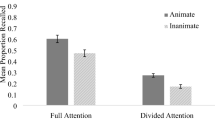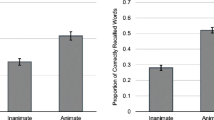Abstract
In this article we report on two experiments concerning the effects of verb frequency and enactment on explicit- and implicit-memory tests. The results showed that verb frequency and enactment had additive effects on (explicit) recognition. Moreover, an (implicit) verb-identification test showed that prior enactment had absolutely no influence on this test, while verb frequency had a clear-cut effect. These results speak in favor of the assumption that verb-frequency and enactment effects are based on different types of information. It is further assumed that the verb-frequency effect is a lexical effect, whereas the enactment effect is not.
Similar content being viewed by others
References
Bäckman, L., Nilsson, L. G., & Chalom, D. (1986). New evidence on the nature of the encoding of action events. Memory & Cognition, 14, 339–346.
Boles, D. B. (1983). Dissociated imageability, concreteness, and familiarity in lateralized word recognition. Memory & Cognition, 11, 511–519.
Bradshaw, J. L., & Gates, E. A. (1978). Visual field differences in verbal tasks: Effects of task familiarity and sex of subject. Brain and Language, 5, 166–187.
Brown, G. D. (1987). Resolving inconsistency: A computational model of word naming. Journal of Memory and Language, 26, 1–23.
Cohen, R. L. (1981). On the generality of some memory laws. Scandinavian Journal of Psychology, 22, 267–281.
Cohen, R. L. (1989). Memory for action events: The power of enactment. Educational Psychology Review, 1, 57–80.
Ellis, A., & Young, A. W. (1989). Human cognitive neuropsychology. Hillsdale, NJ: Lawrence Erlbaum.
Engelkamp, J., & Zimmer, H. D. (1989). Memory for action events: A new field of research. Psychological Research, 51, 153–157.
Engelkamp, J., & Zimmer, H. D. (1994a), The human memory. Seattle: Hogrefe Publishers.
Engelkamp, J., & Zimmer, H. D. (1994b). Motor similarity in subject-performed tasks. Psychological Research, 57, 47–53.
Engelkamp, J., Zimmer, H. D., & Biegelmann, U. E. (1993). Bizarreness in verbal tasks and in subject-performed tasks. European Journal of Cognitive Psychology, 5, 393–415.
Engelkamp, J., Zimmer, H. D., Mohr, G., & Sellen, O. (1994), Memory of self-performed tasks: Self-performing during recognition. Memory & Cognition, 22, 34–39.
Forbach, G., Stanners, R., & Hochhaus, L. (1974). Repetition and practice effects in a lexical decision tasks. Memory & Cognition, 2, 337–339.
Forster, K. I. (1979). Levels of processing and the structure of the language processor. In W. E. Cooper, & E. Walker (Eds.). Sentence processing: Psycholinguistic studies presented to Merrill Marrett. Hillsdale, NJ: L. Erlbaum.
Forster, K. I. (1989). Basic issues in lexical processing. In W. Marslen-Wilson (Ed.), Lexical representation and process. Cambridge, MA: MIT Press.
Forster, K. I., & Chambers, S. M. (1973), Lexical access and naming time. Journal of Verbal Learning and Verbal Behavior, 12, 627–635.
Frederiksen, J. R., & Kroll, J. F. (1976). Spelling and sound: Approaches to the internal lexicon. Journal of Experimental Psychology: Human Perception and Performance, 2, 361–379.
Gardiner, J. M. (1988). Recognition failures and free-recall failures: Implications for the relation between recall and recognition. Memory & Cognition, 16, 446–451.
Gardiner, J. M., Gregg, V. H., & Hampton, J. A. (1988). Word frequency and generation effects. Journal of Experimental Psychology: Learning, Memory and Cognition, 11, 732–741.
Gorman, A. M. (1961). Recognition memory for nouns as a function of abstractness and frequency. Journal of Experimental Psychology, 61, 23–29.
Helstrup, T. (1987). One, two or three memories? A problem-solving approach to memory for performed acts. Acta Psychologica, 66, 37–68.
Hines, D. (1976). Recognition of verbs, abstract nouns, and concrete nouns from the left and right visual half-fields. Neuropsychologia, 14, 211–216.
Howes, D. H., & Solomon, R. L. (1951). Visual duration threshold as a function of word-probability. Journal of Experimental Psychology, 41, 401–410.
Jacoby, L. L. (1983). Perceptual enhancement: Persistent effects of an experience. Journal of Experimental Psychology: Learning, Memory, and Cognition, 9, 21–38.
Jacoby, L. L., (1991). A process dissociation framework: Separating automatic from intentional uses of memory. Journal of Memory and Language, 30, 513–541.
Jacoby, L. L., & Dallas, M. (1981). On the relationship between autobiographical memory and perceptual learning. Journal of Experimental Psychology: General, 110, 306–340.
Kinoshita, S. (1989). Masked and unmasked repetition effects: Activation of representation or procedure? In S. Lewandowski, J. C. Dunn, & K. Kirsner (Eds.), Implicit memory. Theoretical issues. Hillsdale, NJ: L. Erlbaum: (pp. 213–227).
Knopf, M., & Neidhardt, E. (1989). Gedächtnis für Handlungen unterschiedlicher Vertrautheit-Hinweise aus entwicklungspsychologisches Studien. Sprache & Kognition, 8, 203–215.
MacLeod, C. (1989). Word context during initial exposure influences degree of priming in word fragment completion. Journal of Experimental Psychology: Learning, Memory and Cognition, 15, 398–406.
Mandler, G. (1980). Recognizing: The judgement of previous occurrence. Psychological Review, 87, 252–271.
Mandler, G., Goodman, G. O., & Wilkes-Gibbs, D. L. (1982), The word-frequency paradox in recognition. Memory & Cognition, 10, 33–42.
Marslen-Wilson, W. D. (1987). Functional parallelism in spoken word-recognition. Cognition, 7, 1–71.
McClelland, J. L., & Elman, J. L. (1986). The TRACE model of speech perception. Cognitive Psychology, 18, 1–86.
Mohr, G., Engelkamp, J., & Zimmer, H. D. (1989). Recall and recognition of self-performed acts. Psychological Research, 51, 181–187.
Nilsson, L. G., & Böckman, L. (1991). Encoding dimensions of self-performed tasks. Psychological Research, 51, 212–218.
Nyberg, L., & Nilsson, L. G. (this issue). The role of enactment on implicit and explicit memory.
Paivio, A., & Olver, M. (1964). Denotative-generality, imagery, and meaningfulness in paired associate learning of nouns. Psychonomic Science, 1, 183–184.
Richardson J. T. E. (1976). The effects of stimulus attributes upon latency of word recognition. British Journal of Psychology, 76, 205–214.
Roediger, H. K. (1990). Implicit memory. American Psychologist, 45, 1045–1056.
Roediger, H. L., & Weldon, S. (1987). Reversing the picture superiority effect. In M. McDaniel & M. Pressley (Eds.), Imagery and related mnemonic processes. New York: Springer.
Roediger, H. L., Weldon, M. S., Stadler, M. L., & Riegler, G. L. (1992). Direct comparison of two implicit memory tests: Word fragment and word stem completion. Journal of Experimental Psychology: Learning, Memory and Cognition, 18, 1251–1269.
Rubenstein, H., Garfield, L., & Millikan, J. A. (1970). Homographic entries in the internal lexicon. Journal of Verbal Learning and Verbal Behavior, 9, 487–494.
Scarborough, D. L., Cortese, C., & Scarborough, H. S. (1977). Frequency and repetition effects in lexical memory. Journal of Experimental Psychology: Human Perception and Performance, 3, 1–17.
Shanon, B. (1979). Lateralization effects in response to words and nonwords. Cjortex, 15, 541–549.
Snodgrass, J. G., & Corvin, J. (1988). Pragmatics of measuring recognition memory: Applications to dementia and amnesics. Journal of Experimental Psychology: General, 117, 4–50.
Taft, M. (1979). Recognition of affixed words and the word frequency effect. Memory & Cognition, 7, 263–272.
Taft, M. (1991). Reading and the mental lexicon. Hillsdale, NJ: Lawrence Erlbaum.
Whaley, C. P. (1978). Word-nonword classification time. Journal of Verbal Learning and Verbal Behavior, 17, 143–154.
Author information
Authors and Affiliations
Corresponding author
Rights and permissions
About this article
Cite this article
Engelkamp, J., Zimmer, H.D. & Kurbjuweit, A. Verb frequency and enactment in implicit and explicit memory. Psychol. Res 57, 242–249 (1995). https://doi.org/10.1007/BF00431285
Issue Date:
DOI: https://doi.org/10.1007/BF00431285




